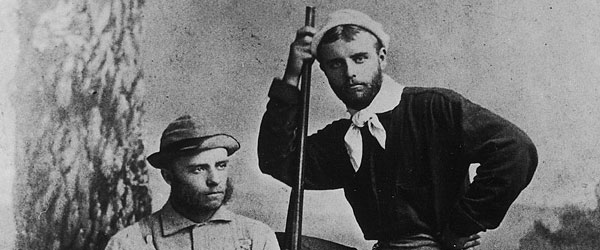You approach the old graveyard with anticipation and trepidation. The slate steps descend in a narrow spiral to a small courtyard where the black gnats give an unwelcomed greeting. It’s a bright August day, but the graveyard is shaded by tall oaks and steamed by dense humidity. “There it is,” declares the sexton, almost proud of the small, churchlike mausoleum ahead of us, now decrepit. Like in the old movies, he flashes an oversized, brass skeleton key. He seems confident that it will unlock the crypt, and it does – on the first try. The heavy metal door creaks open, and sunlight rushes into the stale darkness of the vault. I enter the short, narrow passageway, framed high on either side by Hall family tombs, and stacked one above the other. Very orderly. Very final.
My eyes scan the engravings on the white marble facings, now well-worn by decades of time and obscured in dim light. Below and to my left, as if anchoring the family ambit, I spot the inscription, “Elliott B. Roosevelt” and his dates. But wait, something is wrong. He was not born on February 28, 1859, as the script on his tomb reads. That was only four months after Theodore Roosevelt was born, and he was TR’s brother. Elliott’s birth year was 1860. Even in death, poor Elliott was conflicted.
My journey to find Elliott has taken me to the spare graveyard behind St. Paul’s and Trinity Church in Tivoli, New York, near the upstate Hudson River retreat of the Halls, his wife Anna’s family. A few miles up Woods Road, in Germantown, is another skeleton: the remnants of the abandoned Oak Terrace, the Hall estate and childhood home of the orphaned Eleanor Roosevelt, 20th century first lady and Elliott’s only daughter.
If this feels like the opening of a dark tale, please know that it is – but with shades of light. Elliott B. Roosevelt is often scorned as the “black sheep” of the Roosevelt clans—both Oyster Bay and Hyde Park—a once youthful dude, dashing, charming and filled with promise, but one who was trapped in a nightmare of addiction and marital unfaithfulness. But at the same time, the story presents an uplifting tale of Thee and Mittie Roosevelt’s younger son who revered his daughter, and who, for ten crucial years, shaped the character of the person who would become the “First Lady of the World.”
As a teen, Elliott suffered from severe headaches and seizures, variously diagnosed as hysteria and epilepsy. Unable to compete in school, he sought refuge in the frontier life of Texas and abroad in far-flung big game hunting expeditions. As Elliott struggled with drink and opiates during the 1880s and early ‘90s, Theodore watched with increasing worry. Growing up in Manhattan, they were inseparable friends as well as brothers, sharing a love of their family, athletics and the hunt.
At the time of Elliott’s worst troubles, TR was working in Washington, D.C. pioneering national Civil Service reform and honing a persona geared to the welfare of others. Elliott, on the other hand, had squandered much of his inheritance on social gaiety and self-indulgence. Worse, he had acquired a dependency on opiates from a freak personal injury.
As Elliott’s situation worsened, Theodore took charge. Together with their sisters Bamie and Corinne, he confronted and challenged Elliott, urging him to get straight for his own sake and the family’s good name. When encouragement failed, they enrolled him in one rehabilitation program after another at home and abroad. But the younger Roosevelt’s comeback ultimately was thwarted by the worst of life’s nightmares: the sudden deaths of Anna at 29, and the loss of their toddler son, Elliott, Jr., within a year.
The heroic efforts of Theodore and the Roosevelt sisters to rescue Elliott from himself ended in the summer of 1894. Alone in New York City and dreadfully depressed, Elliott tried but failed to end his life. He died of a convulsion shortly thereafter as he slept. He was 34.
In the 21st Century, Elliott B. Roosevelt should be recalled not just for his trials but for what the Long Island author Raymond Spinzia called an early life of “leadership, athletic prowess, intellectual potential, poetic introspection, a curious mind and a generous, compassionate nature . . .”
Above all, for the sake of history, he was an influential and adoring father. Note Eleanor’s words written many years later: “My father dominated my life as long as he lived, and he was the love of my life for many years after he died. . . . He was the center of my world, and all around him loved him.”
Chip Bishop is the author of “Quentin and Flora – a Roosevelt and a Vanderbilt in Love during the Great War.” He is currently researching a biography of Elliott B. Roosevelt, due for publication in 2016.



